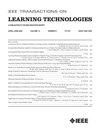利用序列集合模型预测学生参与度
IF 2.9
3区 教育学
Q2 COMPUTER SCIENCE, INTERDISCIPLINARY APPLICATIONS
引用次数: 0
摘要
预测学生的参与度可以提供及时的反馈,帮助教师调整教学方法,满足学生的需求,改善学生的学习体验。本文提出了一种使用序列集合模型进行参与度预测的四步方法,讨论了不同特征对模型的贡献以及视频分割对预测的影响,报告了两个野外数据集--作为学生参与度任务一部分于2018年发布的野外参与度预测中的情感识别(EmotiW-EP)数据集和电子环境中的情感状态数据集(DAiSEE)、最后,提出了全面而透彻的批判性分析,强调了在教育数据集中使用人工智能/计算机视觉模型进行学习时需要考虑的关键因素。实验表明,我们提出的方法在 DAiSEE 数据集上的均方误差为 0.0386,在 EmotiW-EP 数据集上的均方误差为 0.0610,优于最先进的方法。最后,我们对学习环境中此类预测的可靠性进行了批判性分析,并提出了在教育中有效使用人工智能/计算机视觉模型的未来方向。本文章由计算机程序翻译,如有差异,请以英文原文为准。
Predicting Student Engagement Using Sequential Ensemble Model
Predicting student engagement can provide timely feedback and help teachers make adjustments to their practices to meet student needs and improve their learning experience. This article proposes a four-step approach using a sequential ensemble model for engagement prediction, discusses the contribution of different features to the model and the influence of video segmentation in the prediction, reports on two in-the-wild datasets-The Emotion Recognition in the Wild Engagement Prediction (EmotiW-EP) dataset published in 2018 as part of a student engagement task and the Dataset for Affective States in E-Environments (DAiSEE), a general purpose dataset also used in the educational context but not limited to it, and, finally, presents a comprehensive and thorough critical analysis, highlighting crucial factors to consider when using AI/computer vision models in educational datasets for learning purposes. Experiments show that our proposed approach outperforms state-of-the-art approaches by obtaining a mean square error of 0.0386 on the DAiSEE dataset and 0.0610 on the EmotiW-EP dataset. We conclude this article with a critical analysis of the reliability of such predictions in learning environments and propose future directions for the effective use of AI/computer vision models in education.
求助全文
通过发布文献求助,成功后即可免费获取论文全文。
去求助
来源期刊

IEEE Transactions on Learning Technologies
COMPUTER SCIENCE, INTERDISCIPLINARY APPLICATIONS-
CiteScore
7.50
自引率
5.40%
发文量
82
审稿时长
>12 weeks
期刊介绍:
The IEEE Transactions on Learning Technologies covers all advances in learning technologies and their applications, including but not limited to the following topics: innovative online learning systems; intelligent tutors; educational games; simulation systems for education and training; collaborative learning tools; learning with mobile devices; wearable devices and interfaces for learning; personalized and adaptive learning systems; tools for formative and summative assessment; tools for learning analytics and educational data mining; ontologies for learning systems; standards and web services that support learning; authoring tools for learning materials; computer support for peer tutoring; learning via computer-mediated inquiry, field, and lab work; social learning techniques; social networks and infrastructures for learning and knowledge sharing; and creation and management of learning objects.
 求助内容:
求助内容: 应助结果提醒方式:
应助结果提醒方式:


